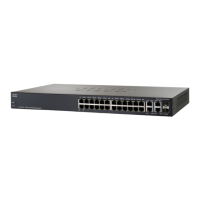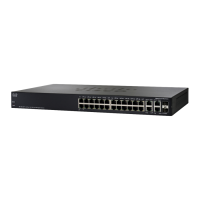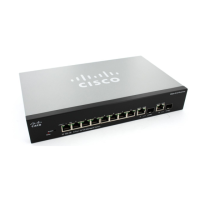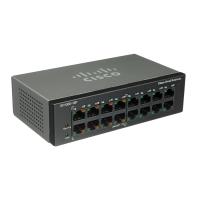VLAN Management
VLAN Groups
206 Cisco Small Business 200, 300 and 500 Series Managed Switch Administration Guide (Internal Version)
13
Defining GVRP Settings
To define GVRP settings for an interface:
STEP 1 Click VLAN Management > GVRP Settings.
STEP 2 Select GVRP Global Status to enable GVRP globally.
STEP 3 Click Apply to set the global GVRP status.
STEP 4 Select an interface type (Port or LAG), and click Go to display all interfaces of that
type.
STEP 5 To define GVRP settings for a port, select it, and click Edit.
STEP 6 Enter the values for the following fields:
• Interface—Select the interface (Port or LAG) to be edited.
• GVRP State—Select to enable GVRP on this interface.
• Dynamic VLAN Creation—Select to enable Dynamic VLAN Creation on this
interface.
• GVRP Registration—Select to enable VLAN Registration using GVRP on
this interface.
STEP 7 Click Apply. GVRP settings are modified, and written to the Running Configuration
file.
VLAN Groups
VLAN groups are used for load balancing of traffic on a Layer 2 network.
Packets are assigned a VLAN according to various classifications that have been
configured (such as VLAN groups).
If several classifications schemes are defined, packets are assigned to a VLAN in
the following order:
• TA G: If the packet is tagged, the VLAN is taken from the tag.
• MAC-Based VLAN: If a MAC-based VLAN has been defined, the VLAN is
taken from the source MAC-to-VLAN mapping of the ingress interface.

